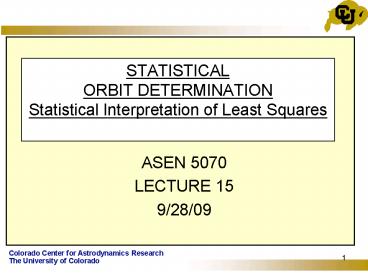STATISTICAL ORBIT DETERMINATION Statistical Interpretation of Least Squares - PowerPoint PPT Presentation
1 / 16
Title:
STATISTICAL ORBIT DETERMINATION Statistical Interpretation of Least Squares
Description:
Title: Statistical Interpretation of Least Squares Author: ccar Last modified by: george Created Date: 9/29/2006 4:06:38 PM Document presentation format – PowerPoint PPT presentation
Number of Views:217
Avg rating:3.0/5.0
Title: STATISTICAL ORBIT DETERMINATION Statistical Interpretation of Least Squares
1
STATISTICALORBIT DETERMINATIONStatistical
Interpretation of Least Squares
- ASEN 5070
- LECTURE 15
- 9/28/09
2
Statistical Interpretation of Least Squares
Show that is an unbiased estimator of ,
i.e.,
where
Assume that 1st two moments of the probability
density function for are known, i.e.,
,
From the least squares solution we have that
But , i.e., is the true
value
Hence,
and is an unbiased estimate of .
3
Statistical Interpretation of Least Squares
Determine the mean and variance-covariance matrix
of the estimation error, , for the weighted
least squares estimate, .
Because is unbiased
With variance-covariance matrix (usually simply
referred to as the covariance matrix), P
From the normal equation
4
Statistical Interpretation of Least Squares
(Cont.)
Substitute into Eq (1)
or
If
Then,
5
Statistical Interpretation of Least Squares
If apriori information and are given,
where
True value
Apriori value
Error in
Assume
Then
We have shown that the normal equation in this
case is
Recall that the estimation error is given by
6
Statistical Interpretation of Least Squares
It can be shown that and
, hence,
and
7
Statistical Interpretation of Least Squares
Define
Then
Assume that and are uncorrelated, then
and
and
8
Statistical Interpretation of Least Squares
Hence, the observation error covariance matrix in
given by
The quantity is
called the information matrix, , i.e.
For example, if
then
If are x and y unobservable?
9
Statistical Interpretation of Least Squares
Recall that
Generally will be a diagonal matrix
If we do not wish to estimate a parameter (say
) we may leave it out of the state deviation
vector or set its apriori variance to a very
small number i.e.,
(say )
This will result in
10
Statistical Interpretation of Least Squares
Demonstrate this for a 2-D case. Let
, assume
Where
and
so and
11
Statistical Interpretation of Least Squares
let
,
then
but
,
,
,
Thus
12
Statistical Interpretation of Least Squares
with
Hence
Note that and is effected by
13
Statistical Interpretation of Least
SquaresExample Problem
I. The state vector is given by
where and are constants. An
a priori value is given with its
relative accuracy described by the matrix,
. Three observations of the state are given by
The relative accuracy of the three observations
is given by the weighting matrix,
1. Set up a step by step algorithm describing how
you would solve for the weighted least squares
estimate, , including use of the a priori
information. Define the , and
matrices (i.e., what is each element of the
matrices).
14
Statistical Interpretation of Least Squares
Answer the following questions 2. Is the
observation state relationship linear or
nonlinear? 3. Was it necessary to use both a
state and observation deviation vector? 4. Do the
and matrices differ for this problem?
Why or why not? 5. Was it necessary to generated
a computed observation for this problem? Why
or why not?
15
Statistical Interpretation of Least Squares
II. Given the system
with the state vector defined by
- Write the linearized equations in state space
form, - How would you determine the state transition
matrix for this system? Is - additional information needed to generate the
state transition matrix?
16
Statistical Interpretation of Least Squares































